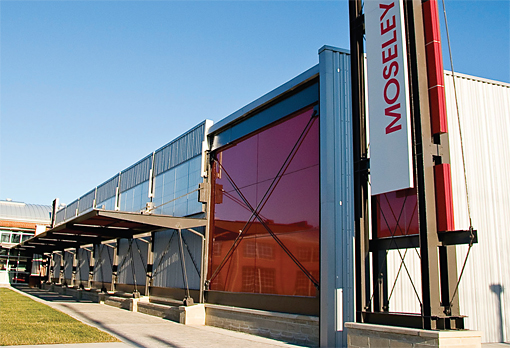| 제목 | [DAIKIN] OFFICE BUILDING - Moseley Architects Headquarters | 작성일 | 16-06-16 11:15 |
| 글쓴이 | 최고관리자 | 조회수 | 2,454 |
본문
CASE STUDY
Office Building
Name
Moseley Architects Headquarters
Location
Richmond, VA USA
Facility Size
1930 historic warehouse - 47,300 ft2 two stories
Issue
Preserving building while increasing HVAC energy efficiencies
Solution
Daikin 140-ton RoofPak® Applied Rooftop system
Green design leader Moseley Architects selects Daikin RoofPak® system for its LEED® Platinum headquarters
Daikin HVAC system contributes to significantly greater energy performance than a conventional rooftop system
A leading architectural firm in sustainable design chose Daikin Applied for its HVAC needs when designing its new headquarters with an eye toward energy efficiency. Moseley Architects selected the Daikin RoofPak Applied Rooftop System when it designed its new headquarters from an old warehouse in Richmond, Virginia.
Daikin HVAC system contributes to significantly greater energy performance than a conventional rooftop system.
A leading architectural firm in sustainable design chose Daikin for its HVAC needs when designing its new headquarters with an eye toward energy efficiency. Moseley Architects selected the Daikin RoofPak Applied Rooftop System when it designed its new headquarters from an old warehouse in Richmond, Virginia.
Energy Performance Design - kBtu/yr (Baseline 90.1)
 HVAC
HVAC
Energy Usage Compliant/Proposed
2,847,181 / 1,537,817
Non-HVAC Energy Usage Compliant/ Proposed
1,276,801 / 973,422
Total Energy Usage Compliant/Proposed
4,123,982 / 2,511,259
Actual Margin of Compliance
36.6%
Building preservation and design
The Moseley Architects' headquarters, a multiple-award winning example of green design, represents a major renovation of two structures: a 1930-built warehouse and a service yard erected in 1957. The warehouse and surrounding area were expanded into a two-story office space of 47,300 sq. ft. accommodating up to 160 architects, engineers and support staff, with an open industrial-look architecture that exposes ductwork and preserves the historical nature of the building.
The building is listed on the National Register of Historic Places and the $10 million project also qualified for $4 million in historic tax credits.
Situated on a 2.37 acre block in Richmond's downtown industrial district, the building earned the U.S. Green Building Council's Leadership in Energy and Environmental Design (LEED®) Platinum certification for new construction and major renovations in 2009. "The building features a number of sustainable elements such as high-efficiency lighting, stormwater management, as well as low flow and waterless plumbing fixtures." says J.T. Smith, mechanical engineer with Moseley Architects in Richmond. "We selected the Daikin 140-ton RoofPak system to achieve as much energy efficiency as we could."
Southern Air, Inc. of Lynchburg, Virginia performed the design and engineering of the HVAC and plumbing for the Moseley building and its Richmond branch office installed the systems. "The Daikin RoofPak is a single package unit that provides all the cooling and the night heating for the building. The evaporatively-cooled system produces much higher efficiency on the cooling cycle than a standard rooftop unit," says Bill Hankins, P.E., director of pre-construction services at Southern Air.
"In addition," Hankins says, "the air economizer produces economical cooling in Virginia's mild weather." For zone heating, baseboard heaters around outside walls serve perimeter heating needs which can be controlled by individual thermostats by end users.

Moseley Architects' Historic Warehouse Prior to Renovation
Detailed planning required
After finalizing design details, renovations were started in fall of 2007 and spanned through September 2008 when Moseley Architects staff moved into the building.
Southern Air contractors worked on-site for more than nine months of the project. "The combination of historic rehabilitation requirements and sustainability objectives produced several synergies but also challenges in terms of energy efficiency and daylight harvesting," Smith of Moseley says, noting the challenges were eventually overcome.
Energy conservation measures for daylight harvesting included abundant use of windows and skylights as well as active control of the solar load through automated blinds. The historic-preservation requirements of the building prevented replacement of its existing single-paned windows though energy-efficient windows could be added.
"We did have a number of obstacles to overcome as a historic building," adds Bryna Dunn, LEED AP BD+C, director of sustainability planning and design at Moseley. "I think we made some very good choices given the constraints of the historic building where we preserved the character."
"Our up-front planning in the early stages made the HVAC installation go smoothly. We put good people on the drawing effort and they did a terrific job of detailing the installation," Hankins says, noting the biggest challenge was the duct work coordination with the existing structure. "Because the building was already in place, field measurements were taken and the ductwork was designed to fit into the truss openings for best use of space. We spent a great deal of effort modeling the duct installation using our 3D ductwork modeling software."
Significant HVAC energy performance
Dunn says the energy performance of the RoofPak unit, along with related HVAC equipment, has met the company's expectations. "The RoofPak contributes significantly to the overall energy efficiency of the building. We looked at the type of HVAC equipment we were going to purchase knowing we had a building envelope that was less than ideal. So, part of our strategy was to be as efficient as we could given the constraints," Dunn says, noting preservation restrictions prohibited insulation of the building's original 14-inch masonry walls.
HVAC—including the Daikin RoofPak unit, variable-air-volume (VAV) terminals, baseboard heaters and additional air conditioning in the server room—comprises just under 67 percent of the building's total entire energy usage. Moseley Architects received LEED credits in Energy and Atmosphere that show the building performance at 36.6 percent better than ASHRAE 90.1-2001 baseline. The building HVAC was modeled against a code baseline system that included a VAV system and electric heat. "The only difference in the as-built HVAC system was the evaporatively-cooled condenser and some control strategies we used," Dunn says.
Moseley Architects also received LEED credits for zero use of ozone-depleting CFCs or HCFC refrigerants. Southern Air worked closely with Moseley Architects on the specifications for the building automation system (BAS) and selected Alerton® controls. Air Conditioning Equipment Sales, Inc. designed the BAS to suit the company's requirements. The system controls the primary HVAC equipment— the Daikin RoofPak and VAV system— via interface with the Daikin MicroTech® III Control with Open Choices® feature which allowed for easy integration with the BACnet® communications protocol.
Information involving HVAC data from the Alerton BAS is fed into a dashboard-style system used by Moseley Architects which incorporates its plug loads, lighting, and other energy-usage information. "We use the dashboard to track energy consumption patterns and ensure optimal performance of our systems. We stay in touch with trends so that we can quickly spot something out of the ordinary," Smith of Moseley says. "From the perspective of general business user, I think they feel inspired and empowered to change personal behaviors and suggest corporate-wide improvements to enhance the efficiency of our building."
To date, the Daikin RoofPak unit is performing well and Moseley Architects looks forward to years of continued use in its green-design showcase headquarters.

Southern Air's 3D Ductwork Modeling Software Enabled Best Use of Space in the Building's Existing Truss System
| 이전글 | [DAIKIN] OFFICE BUILDING - Los Verdes 2016-06-16 | ||
| 다음글 | [DAIKIN] OFFICE BUILDING - One Verizon Way 2016-06-16 | ||






